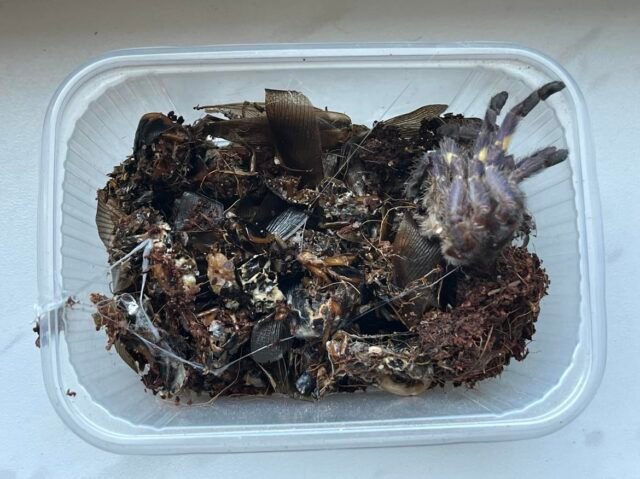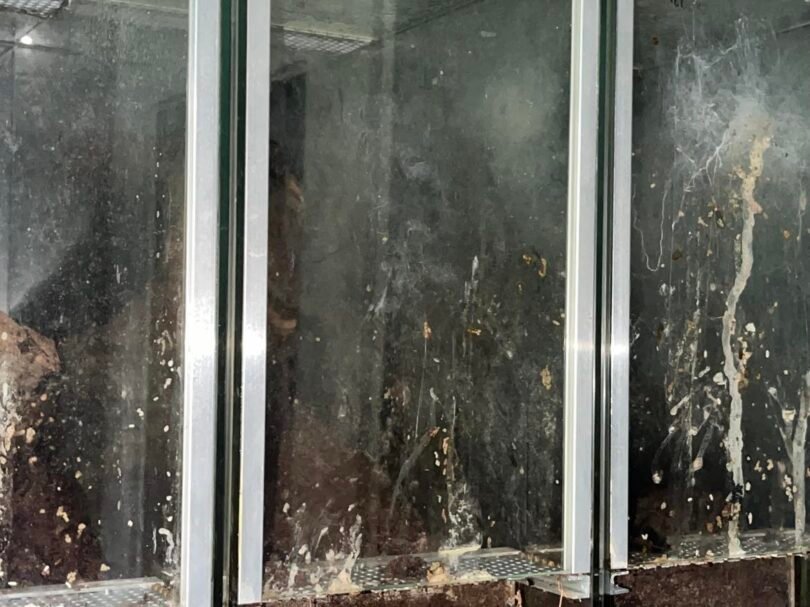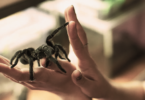Keeping a tarantula’s home clean can be tricky for new spider owners. Regular enclosure maintenance is key to your pet’s health and happiness. This guide will walk you through a simple cleaning routine for your tarantula’s habitat.
Get ready to learn the ins and outs of spider housekeeping!
Frequency of Cleaning

Routine Cleaning of Tarantula Food Remains
Cleaning your tarantula’s home is crucial for its health. Regular maintenance keeps the enclosure fresh and prevents mold and parasite growth.
Routine spot cleaning
Routine spot cleaning is essential and keeps your tarantula’s home fresh and healthy. A quick daily check helps prevent problems. Remove any leftover food or even waste with a damp paper towel. This simple task takes only a few minutes but makes a big difference.
The rule is simple: if you gave your tarantula two roaches yesterday, you can expect to find two leftovers today. If you find them, you’re good until the next feeding.
It is worth removing anything that appears to be abandoned by the spider, such as discarded webbing or molt remnants, as these can promote the growth of unwanted organisms.
If there is a water dish in your tank, you should change the water every other day and thoroughly rinse the dish once a week. If you plan to be away for an extended period and don’t have anyone to take care of it for you, it’s better to leave the dish without water.
Deep cleaning schedules
While daily spot cleaning keeps your tarantula’s home tidy and limits the growth of mites and fungi, deep cleaning is essential for the long-term health of our tarantula and for all the surrounding animals.
Depending on the level of contamination of the substrate and the walls of the terrarium, thorough cleaning every few months prevents the buildup of harmful bacteria and mold.
For deep cleaning, remove your eight-legged friend and all decorations. Wash the tank with mild soap and water, and you can use vinegar for any built-up scale on the tank walls. Let it air dry for at least 3 hours to ensure all chemicals have evaporated, or wipe it down thoroughly.
Replace the old substrate with new substrate, such as compressed bricks or coconut fiber. This refreshes the environment, mimics natural habitat conditions, and most importantly, helps maintain appropriate humidity levels. Don’t forget to clean and disinfect the accessories before returning them to the tank. If the previously used cork tube was heavily infested with mold or had a significant number of mites and you decide to reuse it, you should bake it and dry it thoroughly to eliminate any bacteria and microorganisms.
Isopods and Springtails as Cleaners
Isopods and springtails can be valuable allies in maintaining a clean and healthy environment for your tarantula. Here’s how these tiny creatures help:
- Isopods: These small crustaceans feed on decaying organic matter, such as uneaten prey, waste, and mold. By breaking down these materials, isopods help keep the substrate clean and reduce the buildup of harmful bacteria. They work tirelessly to maintain a balanced ecosystem within the enclosure.
- Springtails: These tiny insects are effective decomposers that thrive on mold and decaying organic matter. They help prevent mold growth and keep the environment fresh by consuming small amounts of detritus and waste.
Adding a small colony of isopods and springtails to your tarantula’s enclosure can somewhat limit the development of mites that are aggressive towards your pet and delay the need for a complete cleaning, including substrate replacement. However, in the average-sized containers used to house tarantulas, it is not possible to create a maintenance-free, self-sustaining environment, and they should only be considered as a supplement.
Final tips from the expert
Sometimes, it may happen that your spider will discard food remains at the bottom of its hide, making it impossible for you to remove them. In such cases, sooner or later, you should rearrange the setup and use new substrate, especially for species that require higher humidity. Also, remember to use different tweezers for cleaning than those you use for feeding.
Regular cleaning ensures a safe and comfortable environment for your tarantula. Stick to a routine and be prepared with the right materials. Your eight-legged friend can take care of its own hygiene but not necessarily the space around it. Remember to provide fresh water and regularly remove leftovers or dead insects. For arboreal tarantulas, whose feces often end up on the front glass, make sure to clean it periodically.
FAQs
1. How often should I clean my tarantula’s enclosure?
Regularly remove leftovers left by your tarantula. If the enclosure looks very dirty, you should replace the substrate and sometimes even the decor elements.
2. What supplies do I need for cleaning a tarantula enclosure?
3. How long to leave food in tarantula enclosure?
It all depends on the type of feeder insects used and the feeding method. If you are feeding with tweezers and the spider is clearly uninterested, you can leave the insect in the enclosure for one day. If you release the insect into the enclosure, you can leave it for a few days to give the spider time to find it.
4. Should you leave uneaten food or dead prey in an enclosure?
Uneaten prey should be removed after a few days, and dead prey immediately. It is also important to check the water bowl to ensure that the food hasn’t drowned in it or turned it into a place for feces.
5. Do tarantulas poop?
Yes, tarantulas do this too, and sometimes it is accompanied by a splashing sound. In terrestrial species, their feces can be hard to notice because they blend in with the substrate. However, in arboreal species, the walls of the enclosure will often be covered with white streaks of feces.







